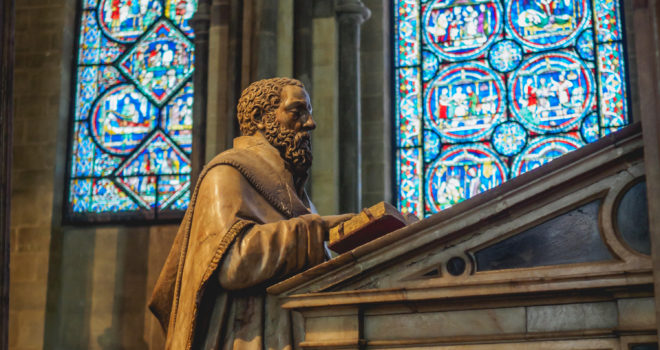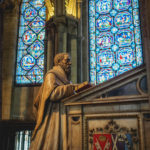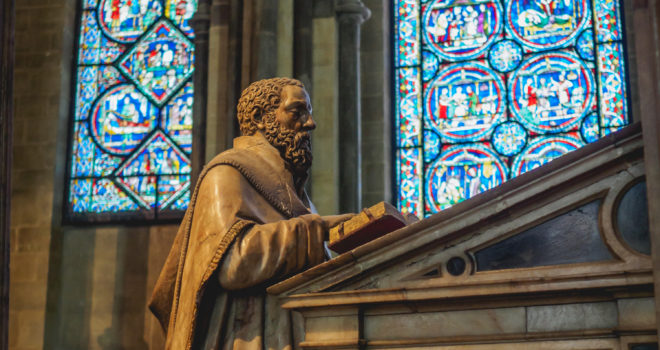
 The murder of St. Thomas Becket may be the most shocking martyrdom in the medieval Church.
The murder of St. Thomas Becket may be the most shocking martyrdom in the medieval Church.
First, there’s the location—the heart of the cathedral of Canterbury, hence the title of T.S. Eliot’s play on the martyrdom (Murder in the Cathedral). Then, there’s the man who was martyred: Thomas Becket, not only an archbishop, but formerly the chancellor of England, a top position akin to Attorney General today. And its timing—just four days after Christmas, on December 29, must have sent a shiver of horror through the Christmas cheer of that year.
But it is the year it happened that might be most shocking.
This was 1170. Catholic Christianity was ascendant over all Europe. The days of persecutions and martyrdoms under imperial Rome were centuries in the past. The disaster of the Reformation was still a few centuries away in the future. This was the year St. Dominic was born, soon to be followed by St. Francis of Assisi. The next century would burn bright with the geniuses of Thomas Aquinas and Dante. It was not for nothing that the great Catholic historian Warren Carroll titled his volume of history encompassing this period The Glory of Christendom.
But, of course, even in these good times there was much that was not well.
In England, King Henry II thought he had his own man in the country’s most prestigious ecclesiastical post when Thomas was consecrated archbishop of Canterbury in 1162. The following year, Henry made his move: seeking to assert legal jurisdiction over members of the clergy facing criminal charges. Today this would be a non-issue, but then such matters were handled by ecclesiastical courts.
It may seem improbable that there could have been so many criminal priests to make this a problem in medieval England. But the ranks of the clergy were expanded to include many minor offices connected with parish and church life. And as Carroll explains, actual criminals disguised themselves as clerics to escape criminal prosecution.
The issue may seem to be a technical one, hinging on the nature of Church law and the proper delineation of who really is a clergyman. But at the root of it all was the fundamental question of to whom the Church owed its obedience: a temporal authority such as the king of England or an authority that was spiritual?
Becket grasped what was at stake. So when Henry forced the English bishops take an oath conceding jurisdiction to the king, Becket inserted a critical caveat: ‘saving our order.’ This presumably allowed them to declare their loyalty to the king as good Englishmen while affirming that the kingdom of God came first.
This was fundamentally the same clash of authority that came to the fore when another king of England also named Henry would break with Rome and found an independent national church over which he had ultimate control. But that was in the 1530s and it may be thanks to Thomas Becket—and the shock waves his martyrdom sent throughout the country and the rest of Christendom—that it did not happen earlier.
The relationship between the king and the archbishop deteriorated rapidly, forcing Becket to flee to France. He offered to resign his position, but the pope would not accept it. Instead, he remained an archbishop in exile for about six years while no headway was made in negotiations with Henry.
Eventually an apparent reconciliation was achieved and Becket returned to England in 1170. But by year’s end, his blood stained the pillar of the cathedral at Canterbury, spilled by the swords of four knights who supposedly acted at the behest of King Henry II.
The reaction to his death was immediate, widespread, and long-lasting. As Carroll puts it “that climactic moment” has been,
…seared into the history of Christendom as by a branding iron. Books, poems, sagas, plays, and the tales of millions of pilgrims over eight centuries have lovingly traced and enshrined every detail of that unforgettable murder in the cathedral (Glory of Christendom, 106).
Within two years, Becket had been canonized. His shrine became among the greatest in Europe, become the setting for Geoffrey Chaucer’s Canterbury Tales. The four knights who slayed him confessed to the pope and were given a crusade as their penance. Even Henry II had to bow to public pressure and make a pilgrimage to the shrine in 1174. Henry II went all the way: wearing a hair shirt and barefoot he kneeled and kissed the spot when Becket was killed. He even had himself whipped by a numbers of bishops, abbots, and monks, according to Carroll.
Henry II never found peace. But England remained solidly Catholic for several centuries to come. As Eliot suggests in Murder in the Cathedral, this all seems to be have been by the design of God:
A Christian martyrdom is never an accident, for Saints are not made by accident. Still less is a Christian martyrdom the effect of a man’s will to become a Saint, as a man by willing and contriving may become a ruler of men. A martyrdom is always the design of God, for His love of men, to warn them and to lead them, to bring them back to His ways.
St. Thomas Becket’s martyrdom is commemorated on the day of his death—and birth into heaven—December 29. In 1170 it came as a shock to the Catholic world. It should today as well, reminding us what is truly at stake in Christmas and for what purpose Christ was born on this earth.










